Animal Tracks
Friday, 25th April 2008 by Alex Turnbull
I wonder what kind of animal left these tracks on these salt flats in South Africa? Are there any animal trackers out there who can identify the creatures responsible?
Part of the National Geographic African Megaflyover Project, this particular image also features some slightly more identifiable tracks, but not left by an animal I suspect...
See our top-rated post of all time - Google Sightseeing Safari - for lots of animals that were still there when the photographs were taken!
Thanks to lepadekor.
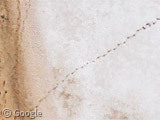
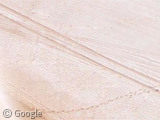
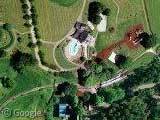

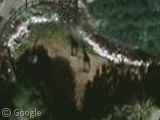
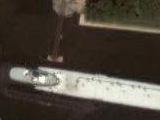
Whatever animal it was it looks like it bowled in from the north, had a wander round, looped back round, discovered that nothing was happening and pretty much carried on wandering. Little does this beast realise that it has got some bored fat fella thousands of miles away writing about it on the internet. Aint life grand?
If I were to guess… I would say camel… just because I have no clue…
Wellington boots
@jack you dont get camels in South Africa………..except maybe in a Tobacconists.
@cookie monster – who you calling fat!?
i think it’s rocks or stones being blown across the desert by the wind. no crap!
With the car tracks nearby, it could be some guy who was just driving around and had to stop to go to the loo and walked around to find a good spot?
@Alex – me!
@dr.R – by the looks of it i dont think privacy is such an issue in that part of the unihabited barren desert.
@ jiminlax & dr.R. – there’s another patch of high-res to the east with many more tracks – which look even more like marks made by some sort of creature. I’m not denying that it could be the human kind of creature of course!
I have no idea what the tracks are, but this object confounds me even more. No idea what it is, but clearly got a prime spot at the corner of two “roads”. Probably a Starbucks.
View Placemark (-27.480943,20.460904)&z=18
I’m going to guess human. The way the tracks go, it looks bipedal. And I doubt you’ll find any other primates in that area.
The footprints are about 75cm apart, so it could be human.
I do know a bit about animal tracking, but next to nothing about how to estimate the proportions of tracks from an aerial image. I’d guess human because whoever said the tracks appear bipedal is correct, and especially given the proximity of a jeep track and what appear to be salt mines (to the northeast), and the otherwise trackless nature. However, if they are too big to be human, try this one on: moving at a certain steady pace and on poor soil where you can’t pick out precise toemarks, elephant tracks appear bipedal because they put their hind feet down almost exactly onto the spot they’ve just lifted their front foot from. Decent example: http://www.youtube.com/watch?v=c37_ZspZi8c& Also, the structure of their foot (flat and with an almost spongy shock-absorbing pad under the bones behind the toes) is such that they walk quite lightly and silently for their size, and leave surprisingly shallow footmarks–due to the large surface area of their feet–even when moving quickly. As I said, I would guess human, but there are a few quadrupeds with unusual walks that can make apparently bipedal prints.
Those are elephant tracks, very distinct because they are round, actually more oval. You can see the direction the animal was moving in by looking at the drag marks left by the toes, in this case going from left to right in the photo. This photo is actually in Botswana.